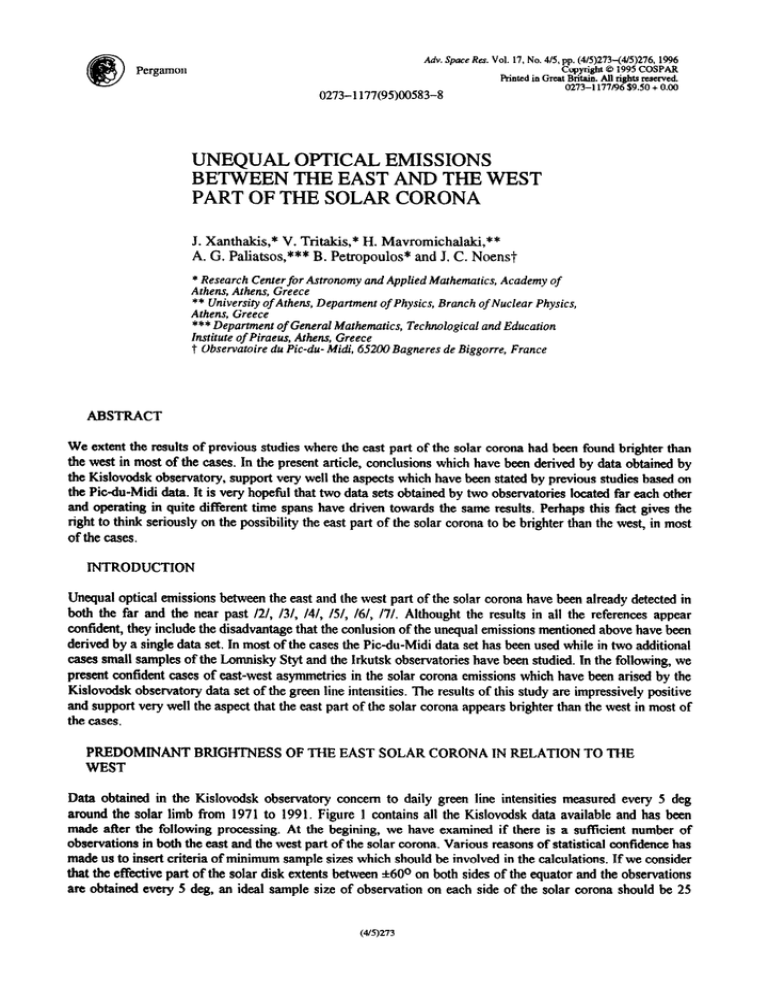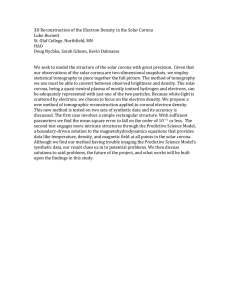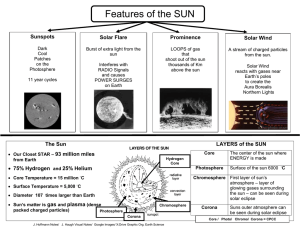
Adv.SpaceRer.Vol.
17,No.4/5,pp.(4/5)273-(4/5)276,
1996
~~~~1995COSP~
Printed in Grat B&a&. All rights reserved.
K&73-1177/96$9.50+0.00
0273-1177(95)00583-8
~NEQ~~
OPTICAL E~ISSI~NS
BETWEEN THE EAST AND THE WEST
PART OF THE SOLAR CORONA
J. Xanthakis,* V. T&.&is,* H. Mavromi~h~~,**
A. G. Paliatsos,*** B. Petropoulos* and J. C. Noens?
* Research Centerfor Astronomyand AppliedMathematics,Academyof
Athens,Athens, Greece
** Universityof Athens,Departmentof Physics,Branch of Nuclear Physics,
Athens, Greece
*** Depart
of General Mai~~tics, ~ec~~ogica~ and Education
t~titute of Piraeus, Athens, Greece
t Observatoiredu Pit-du- Midi, 65200 Bagneres de Biggorre, France
ABSTRACT
We extent the resuits of previous studies where the east part of the solar corona had been found brighter than
the west in most of the cases. In the present article, conclusions which have been derived by data obtained by
the Kisiovodsk observatory, support very well the aspects which have been stated by previous studies based on
the Picdu-Midi data. It is very hopefui that two data sets obtained by two observatories located fat each other
and operating in quite different time spans have driven towards the same resuits. Perhaps this f&t gives the
right to think seriously on the possibility the east part of the solar corona to be brighter than the west, in most
of the cases.
MTRODUCTION
Unequal optical emissions between the east and the west part of the solar corona have been already detected in
both the far and the near past 121, 13f, /41, i5f, 161, 171. Althought the results in ail the references appear
confident, they include the disadvantage that the coniusion of the unequal emissions mentioned above have been
derived by a single data set, In most of the cases the Picdu-Midi data set has been used while in two additional
cases small samples of the Lotnnisky Styt and the Irkutsk observatories have been studied. In the following, we
present confident cases of east-west asymmetries in the soiar corona emissions which have been arised by the
Kisiovodsk observatory data set of the green line int~s~ti~. The results of this study are impressively positive
and support very well the aspect that the east part of the solar corona appears brighter than the west in most of
the cases,
PREDOMINANT BRIGHTNESS OF THE EAST SOLAR CORONA IN RELATION TO THE
WEST
Data obtained in the Kisiovodsk observatory concern to daily green line intensities measured every 5 deg
around the solar limb from 1971 to 1991. Figure 1 contains ail the Kisiovodsk data available and has been
made after the following processing. At the begining, we have examined if there is a sufficient number of
observations in both the east and the west part of the solar corona. Various reasons of statistical confidence has
made us to insert criteria of m~imum sample sizes which should be involved in the caicuiations. If we consider
that the effective part of the solar disk extents between %60° on both sides of the equator and the observations
are obtained every 5 deg, an ideal sample size of observation on each side of the solar corona should be 25
(4L5)273
J. Xidmkis et al.
@IS)274
measurementsper day of observation.
After a serious consideration of observation losses and gaps, the minimum sample size criteria which have been
inserted are cosistent with 10 measurements on each side of the solar corona at least as well as a sample size
difference between the two sides not less than 6. The purpose of this sample size liminations is to protect to
some extent the confidence of our results from the induction of very unequal sample size effects between the
east and the west solar corona. Sample sizes which finally participate in our calculations have been tabulated in
the table 1. All the data which have been satisfied the above mentioned criteria they have been separated in 27
time series which start from the 27 foremost dates of the record and contain data every 27 days. In this way,
each time series contains data with time lag of 27, that is data which correspond to the same more or less areas
after succesive solar rotations.
TABLE 1 Total number of daily observations obtained by Kislovodsk observatory which participate in our
calculations.
TIME SPAN
TOTAL NUMBER
OF DAILY
OBSERVATlONS
1971-1991
2265
NUMBER OF
OBSERVATIONS
THEY DO NOT
FULFIL
CRITERIA
378
NUMBER OF
OBSERVATIONS
THEY PARTICIPATE
IN OUR
CALCULATIONS
1887
L
In the following, we have calculated the asymmetry coefficient A=(E-W)/(E+W), where E, W the mean
intensity within tbe latitudinal zone *60 o on both sides of the solar equator of the east and the west solar limb
respectively. In the Figure 1 the number of cases for each of the 27 time series where the east part of the solar
corona appears brighter (IE>IW) or fainter (IE<IW) than the west, has been depicted. From this figure, it is
more than evident that the number of cases where the east part is brighter than the west predominate by a
factor of 3 to 4.
100
KISLOVODSK
-60' - +20@
I, > Im-r* I, c I.
Fig. I. Number of cases where the east part of the solar corona appears brighter (IEBIW) or fainter (IE<IW)
than the west in the green spectral emission.
(4/5)275
Unequal Optical Emissions in the Solar Corma
In a recent paper, all the possible errors which could introduce a pseudo-asymmetric emission between the east
and the west part of the solar corona have been discussed Ill. The final. conclusion of that article was that
atmospheric diffision during early observations could overestimate the east limb measurements. In our effort to
exclude the possibility of a diffision error, in the present study we have separated the data set under
consideration in two samples. The first sample contains all the early observations that is, observations made
before 07.30 UT while the second contains those made after this critical time. The Figures 2 (a) and 2 (b) are
similar to the Figure I and represent results which have been derived by the application of the same processing
which has been made for the Figure I, on the two data samples mentioned previously. It is evident that the east
part of the solar corona appears brighter than the west in both of the samples that is, the predominance of the
east brightness on the west is indepentent from the time when the observations have been made. In other words,
Fig. 2. (a) Number of cases where the east part of the solar corona appears brighter (IEXW) or fainter
(IE<Iw) than the west in the green spectral emission for observations obtained before 07.30 UT, when the sun
is located close to the horizon and the diffusion error predominates. (b) Similar to (a) concerning to data
obtained after 07.30 UT, when the sun is located far from the horizon and the diffusion error has been
minimized.
In the Figure 3 the variation of the green line intensity for each solar quarter for the time span I97 I - 199 I has
been depicted. If we take in mind the correspondance l=Northeast, 2=Southeast, 3=Northwest, rt=Southwest, it
is very interesting that the Northeast solar quarter which in the time span 1946-1970 had been found to appear
brighter than the others, in the period 1971-199 I does not predominate any more but a slight excess of the
southeast quarter brightness is obvious /7/.
78,
PSLOVODSK
0.e..
-*++a.*
Imt
2nd
3rd
4th
quutur
quarter
quarter
quarter
Fig. 3. Yearly values of the green line intensity calculated in each solar quarter, separately.
@IS)276
I. Xeabkis et al.
This probably has to do with a new 22-year solar magnetic cycle which started at the beginning of the seventies
and reversed the principal polarity of the sun transforming in the the well-known N-S asymmetry of the solar
magnetic field in S-N.
DlSCUSSiON
The analysis of the data set obtained by the Kislovodsk observatory came to support in the best way the aspect
we have already presented in previous ~mmunications. Detailed studies on the Pi&u-Midi data set have been
pointed out that the east solar corona part appears brighter than the west in all the optical emissions. The same
result in the most impressive way has been also come out from the Kislovodsk data, reducing drastically the
possibility that this inequality has been induced by some kind of error. It is noteworthy that positive cases that
is, cases where the east part of the corona appears brighter than the west, have been counted three to four times
more than the megative. After all, it is very difficult for somebody to accept that two quite different data sets
obtained by two different observatories far each other could present the same effect which has been introduced
by the same reason. Nevertheless, additional verification by data sets of other observatories is necessary before
we start thinking about physical mechanisms which could make the east solar corona to appear brighter than
the west in all the optical emissions.
REFERENCES
1. J. C. Noens, V. Tritakis and A. Paliatsos, Possible errors in coronographic observations which could
introduce asymmetric emissions from antidiammetric points of the solar limb, Proceed of the No. I44 IAU
‘~yrn~si~rn, in press.
2. L. Pajdusakova, The asymmetry of the solar corona, Contributions of the Astronomical Observatory,
Skalnate Pleso,
&6(1966).
3. J. Sykora, Some remarks on the summary use of existing corona measurements, BAC, a(l),
12(197 1).
4. M. Trellis, Dissymetrie Es&Quest des Intensities de la couronne monochromatique, C. R. Academic de
Sciences, Paris 250,58-60( 1959).
5. V. T&&is, H. Mavromichalaki and B. Petropoulos, Asymmetric variations of the coronal green line
intensity, Sol. Phys., 11$, 367( 1988).
6. N.F. Tyagun and M. Rybansky, E-W Asymmetry in the monochromatic corona (in Russian language), Phys.
Solariterr., Potsdam, # 17, 19 (198 1).
7. J, Xanthakis, J-J.Mavromichalaki, B. Petropoulos, V. P. Tritakis, L. ~a~a~ou~,
A. Vasilaki, J.C. Noens,
L. Leroy, and B. Pech, Asymmetries of the green and red line intensities of the solar corona, Adv. Space Res.
U(l), 169(1991).
8, J. Xantbakis, J. C. Noens, B. Pech, H. Maur~ichal~i,
V, P. T&&is, B. Petropoulos and A. Pahatsos,
Evidence of asymmetric variation of the emissions of the solar corona, Proceed. of the No. 144 IAU
Symposium, in press.


